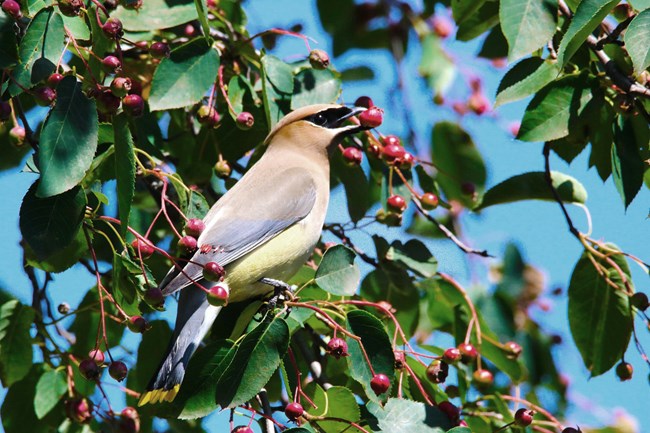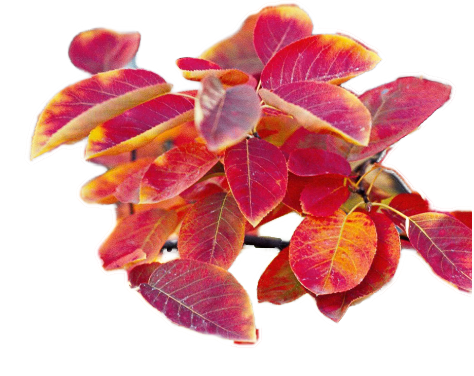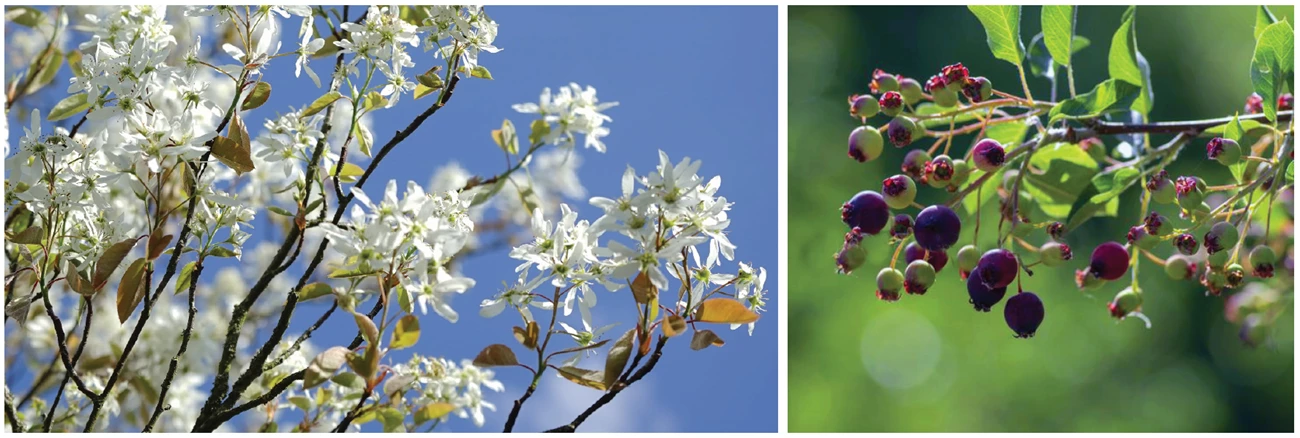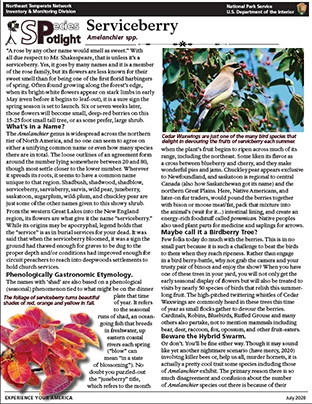Last updated: August 15, 2021
Article
NETN Species Spotlight - Serviceberry


“A rose by any other name would smell as sweet.” With all due respect to Mr. Shakespeare, that is unless it’s a serviceberry. Yes, it goes by many names and it is a member of the rose family, but its flowers are less known for their sweet smell than for being one of the first florid harbingers of spring. Often found growing along the forest’s edge, when its bright-white flowers appear on stark limbs in early May (even before it begins to leaf-out), it is a sure sign spring wildflower season is set to launch. Six or seven weeks later, those flowers will become small, deep-red berries on this 15-25 foot small tall tree, or as some prefer, large shrub.
What’s in a Name?
The Amelanchier genus is widespread across the northern tier of North America, and no one can seem to agree on either a unifying common name or even how many species there are in total. The loose outlines of an agreement are formed around the number lying somewhere between 20 and 80, though most settle closer to the lower number. Wherever it spreads its roots, it seems to have a common name unique to that region. Shadbush, shadwood, shadblow, serviceberry, sarvisberry, sarvis, wild pear, juneberry, saskatoon, sugarplum, wild-plum, and chuckley pear are some other names given to this showy shrub.
From the western Great Lakes into the New England region, its flowers are what give it the name “serviceberry.” While its origins may be apocryphal, legend holds that the “service” is as in burial services for your dead. It was said that when the serviceberry bloomed, it was a sign the ground had thawed enough for graves to be dug to the proper depth and/or conditions had improved enough for circuit preachers to reach into deepwoods settlements to hold church services.

Phenologically Gastronomic Etymology.
The names with ‘shad’ are also based on a phenological (seasonal) phenomenon tied to what might be on the dinner plate that time of year. It refers to the seasonal runs of shad, an ocean-going fish that breeds in freshwater, up eastern coastal rivers each spring (“blow” can mean “in a state of blossoming”). No doubt you puzzled-out the “juneberry” title, which refers to the month when the plant’s fruit begins to ripen across much of its range, including the northeast. Some liken its flavor as a cross between blueberry and cherry, and they make wonderful pies and jams. Chuckley pear appears exclusive to Newfoundland, and saskatoon is regional to central Canada (also how Saskatchewan got its name) and the northern Great Plains. Here, Native Americans, and later-on fur traders, would pound the berries together with bison or moose meat/fat, pack that mixture into the animal’s (wait for it...) intestinal lining, and create an energy-rich foodstuff called pemmican. Native peoples also used plant parts for medicine and saplings for arrows.
Maybe call it a Birdberry Tree?
Few folks today do much with the berries. This is in no small part because it is such a challenge to beat the birds to them when they reach ripeness. Rather than engage in a bird berry-battle, why not grab the camera and your trusty pair of binocs and enjoy the show? When you have one of these trees in your yard, you will not only get the early seasonal display of flowers but will also be treated to visits by nearly 50 species of birds that relish this summer-long fruit. The high-pitched twittering whistles of Cedar Waxwings are commonly heard in these trees this time of year as small flocks gather to devour the berries. Cardinals, Robins, Bluebirds, Ruffed Grouse and many others also partake, not to mention mammals including bear, deer, raccoon, fox, opossum, and other fruit-eaters.

Beware the Hybrid Swarm.
Or don’t. You’ll be fine either way. Though it may sound like yet another nightmare scenario (have mercy, 2020) involving killer bees or, help us all, murder hornets, it is actually a pretty cool trait some species including those of Amelanchier exhibit. The primary reason there is so much disagreement and confusion about the number of Amelanchier species out there is because of their tendency to cross-pollinate and hybridize with each other. Assemblages of species that do this are sometimes referred to as a “hybrid swarm.” Some evolutionary biologists believe this is the early stages of the evolution of a new species when populations are just beginning to become genetically different from each other. Meriwether Lewis of Lewis & Clark fame recognized the differences between the “survice berry” he was familiar with than those he was encountering while exploring the West (see inset).
And Synchronicity II
All Amelanchier species bloom about the same time. This synchronous bloom happens not only across species but on the tree itself too. When flowers all open at the same time, it improves the odds of attracting pollinators and therefore creating more seed-producing berries. Amelanchier trees produce bumper-crops of berries about every 3rd year. They employ the opposite strategy for berry ripening, doing so on an asynchronized schedule from June into August. Trees that have multi-colored berries (some green, some red, some a deep purple) in varying stages of ripeness are magnets for birds, which can distribute the seeds therein many miles away.
The earlier ripening berries contain the most seeds, about 10 per berry, again increasing the odds of seed dispersal. Not many other wild berries are ripe yet come June/early July in the North, making those of Amelanchier more likely to be devoured by hungry birds, many of which are still raising chicks. By late summer, as other fruit producing plants are coming into full ripeness, competition is at its peak for birds’ attention. Not fully throwing in the towel, Amelanchiers still have some berries coming ripe at this time, but not nearly as many, nor do they contain as many seeds with only one or two per berry. This kind of may-as-well-still-try-but-don’t-put-too-much-effort-into-it strategy ensures the tree is focusing its limited resources on producing the most seed-rich berries at the optimal time of year for seed-dispersal success.
A Climate Change Canary
Amelanchier species usually bloom for a very short period, 3 to 5 days on average, making them useful for tracking how bloom times have changed over the past century plus. A University of Delaware study looked at dozens of herbarium observations around the Philadelphia area and found that it blooms about 25 days earlier than it did in 1840. Amelanchier flowered about 2-days earlier for every 1-degree Fahrenheit increase in average monthly minimum temperature for March and April. Similar results were found from analyzing Henry David Thoreau’s observations of the plant in Concord, MA from 1852-1858. Resurveys showed flowering times shifted 1.8 days earlier for each degree F of change in average January temperature. Aldo Leopold also recorded flowering times of Amelanchier near his south-central Wisconsin home from 1935 to 1945, noting flowering ranged from April 10 to May 9. When resurveyed from 1977 to 2012, average flowering time had shifted by 2.3 days per degree. Serviceberry’s in 2012 (warmest spring on record for the area) flowered at the earliest date ever recorded there: March 25th, 24 days earlier than recorded by Leopold.
For more information
- Learn more about the bird species attracted to Amelanchier plants.

Tags
- acadia national park
- appalachian national scenic trail
- eleanor roosevelt national historic site
- home of franklin d roosevelt national historic site
- marsh - billings - rockefeller national historical park
- minute man national historical park
- morristown national historical park
- saint-gaudens national historical park
- salem maritime national historical park
- saratoga national historical park
- saugus iron works national historic site
- vanderbilt mansion national historic site
- weir farm national historical park
- species spotlight
- netn
- inventory and monitoring division
- amelanchier
- birds
- native plants
- serviceberry
- shadbush
